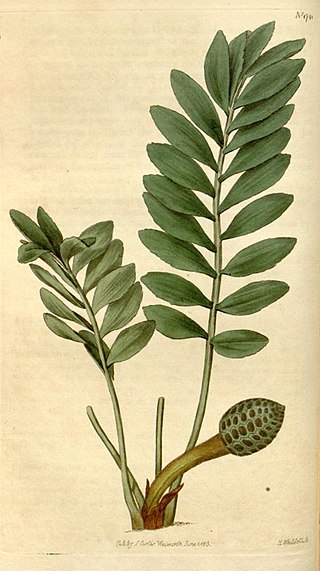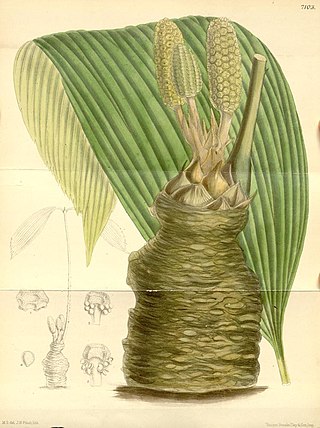
Zamia is a genus of cycad of the family Zamiaceae, native to North America from the United States throughout the West Indies, Central America, and South America as far south as Bolivia. The genus is considered to be the most ecologically and morphologically diverse cycads, and is estimated to have originated about 68.3 million years ago.
Chigua is a genus of cycads in the family Zamiaceae containing two species, endemic to small areas in northwestern Colombia. Described by botanist Dennis Stevenson in 1990, it is the most recently named genus, and the name refers to a Spanish transliteration of the common name given to cycads by the indigenous peoples of Colombia. The species are found in wet lowland rainforests at 100–200 m altitude.
Zamia amplifolia is a species of plant in the family Zamiaceae. It is endemic to the Calima River watershed of Valle del Cauca Department, Colombia. It is threatened by habitat loss.

Zamia angustifolia is a species of plant in the family Zamiaceae. It is found in the Bahamas and Cuba. It is threatened by habitat loss.
Zamia boliviana is a species of plant in the family Zamiaceae. It is endemic to Bolivia and Mato Grosso, Brazil.
Zamia cremnophila is a species of plant in the family Zamiaceae. It is endemic to the state of Tabasco in Mexico, between Teapa and Tapijulapa.
Zamia hymenophyllidia is a species of plant in the family Zamiaceae. It is found in Colombia and Peru. In Peru, it is found in Maynas, Pebas, and Brilla Nueva. It is threatened by habitat loss.
Zamia lecointei is a species of plant in the family Zamiaceae. It is found in Brazil, Colombia, Peru, and Venezuela. It is threatened by habitat loss.
Zamia macrochiera is a species of plant in the family Zamiaceae. It is endemic to Peru. It is found near the towns of Pebas and Pucaurquillo in Maynas Province, Loreto Region; plants are found near the Rio Amiyacu and Rio Napo. It is threatened by habitat loss, and is considered critically endangered by the IUCN.
Zamia manicata is a species of plant in the family Zamiaceae. It is found in Colombia and Panama. Its natural habitat is subtropical or tropical moist lowland forests. It is threatened by habitat loss.
Zamia montana is a species of plant in the family Zamiaceae. It is endemic to Antioquia Department, Colombia. Its natural habitat is subtropical or tropical moist montane forests. Zamia montana is extremely rare and is unknown in cultivation. Its habitat is also extremely threatened by logging activities. In fact, it may well be extinct in the wild because the only known population occurs in an area that was recently logged.

Zamia obliqua is a species of plant in the family Zamiaceae. It is found in Colombia and Panama. Its natural habitat is subtropical or tropical moist lowland forests. It is threatened by habitat loss.

Zamia poeppigiana is a species of plant in the family Zamiaceae. It is found in Colombia, Ecuador, and Peru. It is threatened by habitat loss.

Zamia portoricensis, the marunguey, is a species of plant in the family Zamiaceae. It is endemic to Susua State Forest region of western Puerto Rico.
Zamia prasina is a species of plant in the family Zamiaceae. It is native to Yucatán, Campeche, Quintana Roo, Tabasco and Chiapas in Mexico and Guatemala and Belize. Its natural habitat is subtropical or tropical moist montane forests. It is threatened by habitat loss.

Zamia pseudoparasitica is a species of plant in the family Zamiaceae. It is endemic to Panama. Its natural habitat is subtropical or tropical moist lowland forests on the Atlantic side of the isthmus. It is threatened by habitat loss.

Zamia pygmaea is a species of plant in the family Zamiaceae found only in Cuba. It is the smallest living cycad. It is listed as critically endangered on the IUCN Red List based on its limited distribution, severely fragmented habitat, and population of less than 250 mature individuals.

Zamia roezlii is a species of cycad, a palm-like pachycaulous plant in the family Zamiaceae. It is found in Colombia and the Pacific coast of Ecuador. It is named for the Czech botanist Benedikt Roezl. A single sperm cell from Zamia roezlii is about 0.4 mm in length and is visible to the unaided eye, being the world's largest plant sperm cell. Drosophila bifurca, a species of fruit fly, has sperm that are 5.8 cm long, albeit mostly coiled tail. The tree is up to 22 feet in height with fronds up to ten feet long bearing leaflets up to twenty inches long and six inches wide.>

Zamia skinneri is a species of plant in the family Zamiaceae. It is endemic to the coastal area of mainland Bocas del Toro Province, Panama. Its common name is cebolla roja.

Zamia wallisii is a species of plant in the Coontie Family (Zamiaceae). It is endemic to Colombia. Its common name is chigua.











